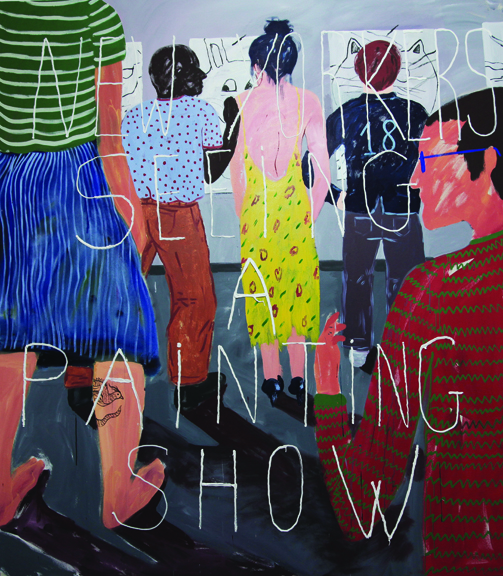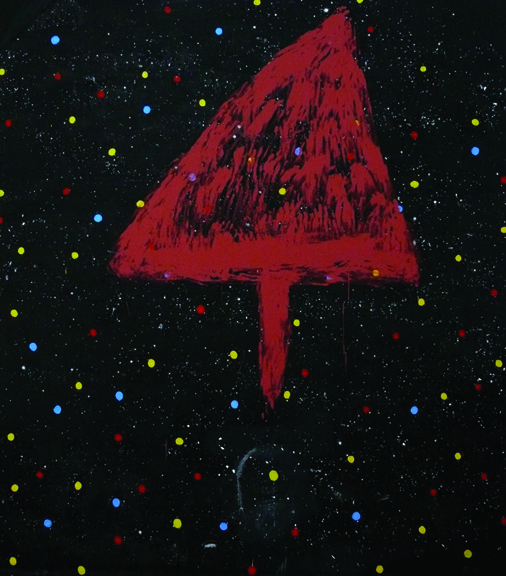Florian Meisenberg: How do you perceive and process the images or ideas you are trying to visualize in your paintings?
Cristina de Miguel: Most of the images I use come from my mind. Normally I visualize them in my mind unexpectedly, especially when I’m lying on my bed about to sleep and my eyes are closed. A lot of ideas for new paintings pop up then. I also pay a lot of attention to the formal side of daily images and events. It is like thinking in images all the time: Then painting becomes a life style.
FM: Do you like sitting in front of a blank canvas?
CM: Yes. I enjoy the silence of a blank canvas while my mind is speeding, full of thoughts – thoughts of what to do or not to do on it. I’m always very sure of that starting decision. I need to have pride in the work from the first step, otherwise the painting won’t work. I have never given birth, but I think you need to be proud of your child to raise them properly.
FM: Do you use a sketchbook or sketches to prepare/construct a painting?
CM: Not really. Every so often I will just to be sure of how a painting will end up. Every time I try to use a sketch I end up doing something different. I get very rebellious with any kind of auto imposition. So sketching serves me for not following a sketch. A planned process bores me. When I know what exactly is going to happen everything loses it sense, I don’t have interest in doing it anymore. What I want with my paintings is to bring the unexpected. However, when I see or imagine a certain form that may interest me for future paintings, I usually draw it in order to remember it, but that is different. I guess the sketches I use are mental ones, so they are easier to modify depending on what the actual painting is asking for. I keep things very flexible.
FM: What is your relation to the idea of genius?
CM: I always wanted to be a genius. When I was an early teenager I used to make comparisons between Dali’s and Picasso’s biographies and mine, things like, “Ok, he started to paint when he was 10, so I’m in the right track, I’m 11 and painting as well.” Cézanne’s late artist vocation really cheered me up to keep painting; I had a lot of years to become a genius. All these were secret thoughts, in that time I’d be very embarrassed to tell somebody about that ambition. Now, all that makes me laugh, obviously.
FM: How does the clay work of your childhood relate to your recent work?
CM: I think they are connected in the way that I was free to do pieces with no relation between their subjects. And I wasn’t worried if they made sense or not. That was not important for me in that time, and neither is it now.
FM: And how to you see and apprehend the clay sculptures today?
CM: I like to see how some of them can be conceived with a different approach than others. I try to do that now in my paintings—to be so free to contradict myself.
FM: Do you think that you are a conceptual painter?
CM: If a conceptual painter is one for whom the idea is more important than the form, I’m not. Because for me, in my painting, the idea is the form.
FM: Are you trying to tell anecdotes?
CM: I think that what I do is closer to visual poetry than to pure narrative. I want my paintings to be open to different interpretations rather than forcing the viewer to have just one.
FM: How do you feel as a painter and object maker in a world of contemporary ephemeral ecstasy?
CM: Perhaps because I belong to that world, I don’t have the distance necessary to see it. I like when paintings collect the passage of time and events. For example, when the canvas’ edges get scuffed from dragging them along the studio, and have the marks of accidents, hairs, cigarette butts and loose staples crusted on the paint. All this tells us something else about the paintings that an image can’t. Something about a certain time and space that is already gone. Paintings are ephemeral. That’s something I am conscious about.
FM: Are you a natural born painter?
CM: Yes, I always wanted to be a painter. It is something I didn’t choose, it is just what I do the best. Sometimes I dream about painters I like too.
FM: Are you writing, or follow any other way of trying to express the inexplicable?
CM: Sometimes I write, but just to clarify what is on my mind. In this moment of my life I only want to do paintings. But who knows what I will want to do in 10 years!
FM: How do you perceive the struggle (if it is one for you) or relation of intuition and concept?
CM: Ah, intuition is so powerful. There are so many things we don’t notice –rationally- that are there! I do believe that intuitive decisions are the essence of painting. Once decisions are made, if I examine them rationally I will find the reason why I chose to do this or that. It is really surprising.
FM: Why is the NIKE logo painted so awkward?
CM: The actual Nike logo comes from the idea of the Greek deity Nike, god of speed and victory. That is why it has that stylized wing shape, which gives a sense of forward movement. It is very hard to draw a perfect Nike sign, I don’t really know why. In Nike Painting the logo has the opposite features of the real one; it is really chubby and rudimentary. But does it still represent the actual one? It is claiming its dignity as a painting.
FM: Do you consider painting as another form of existential philosophy?
CM: Oh yes. Paintings are based on personal experiences and offer a subjective way to perceive reality. I think painting can’t escape from containing any kind of existential statement because it is conceived from the uniqueness of the individual. It is implicit in its own nature of human expression.
FM:What is the drama of human existence for you?
CM: The fact that we are each a self-contained unique universe, makes every second so rich. It is inconceivable how easily time vanishes.
FM: Do you like Nietzsche?
CM: I’m not very into Nietzsche. But I’m truly inspired by what he says, “He who has a ‘why’ to live can bear almost any how.”
FM: Do you have a mission and what is your mission?
CM: Yes. And I think we all have a mission too. Mine consists of going every day to the studio to paint.
FM: Do you believe in god?
CM: Oh yes. I believe that God is with and within every person in the form of love. I also believe in Jesus. All what he said and did amaze me. I wish I could always act as he suggested in his teachings.
FM: What does painting do for you?
CM: It is a lifestyle. A way to live and understand life.
FM: Tell me in a sentence who you are.
CM: A painter with pimples.

























